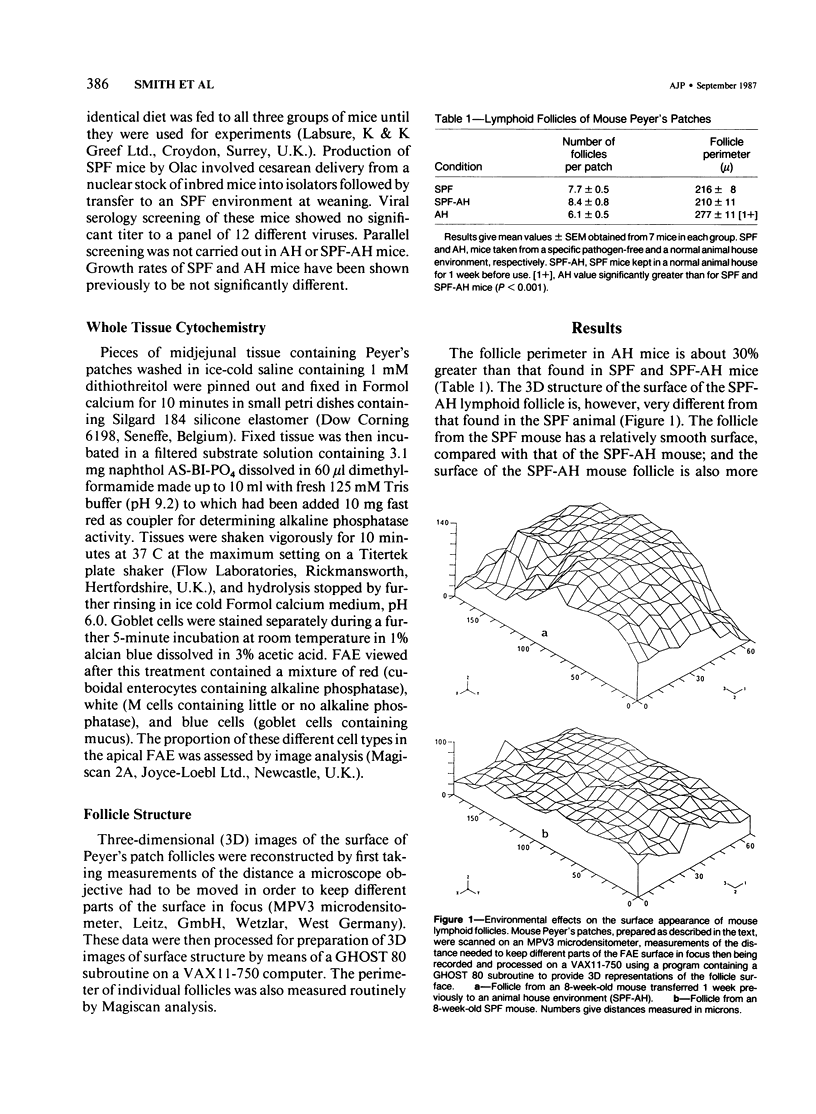Abstract
M cells present in the follicle-associated epithelium (FAE) of mouse Peyer's patches take up and transport enteric antigens to the underlying gut-associated lymphoid tissue (GALT) for subsequent processing by lymphocytes and macrophages. Present experiments use a new type of cell-labeling technique in attempts to measure the number of M cells present in the FAE of specific pathogen-free (SPF) and normal animal house reared (AH) BALB/c mice. Results show the apparent M-cell area to increase threefold 7 days after transfer of SPF mice to an AH environment. This change takes place without significantly affecting the area of FAE occupied by goblet cells. It is suggested from these results that M-cell production can be selectively increased within the FAE through the presence of foreign antigens and that this effect could have general importance in controlling the overall GALT response to enteric infection.
Full text
PDF




Images in this article
Selected References
These references are in PubMed. This may not be the complete list of references from this article.
- Befus D., Bienenstock J. Factors involved in symbiosis and host resistance at the mucosa-parasite interface. Prog Allergy. 1982;31:76–177. [PubMed] [Google Scholar]
- Bhalla D. K., Owen R. L. Cell renewal and migration in lymphoid follicles of Peyer's patches and cecum--an autoradiographic study in mice. Gastroenterology. 1982 Feb;82(2):232–242. [PubMed] [Google Scholar]
- Bienenstock J., Befus A. D. Mucosal immunology. Immunology. 1980 Oct;41(2):249–270. [PMC free article] [PubMed] [Google Scholar]
- Bye W. A., Allan C. H., Trier J. S. Structure, distribution, and origin of M cells in Peyer's patches of mouse ileum. Gastroenterology. 1984 May;86(5 Pt 1):789–801. [PubMed] [Google Scholar]
- Carter P. B., Collins F. M. The route of enteric infection in normal mice. J Exp Med. 1974 May 1;139(5):1189–1203. doi: 10.1084/jem.139.5.1189. [DOI] [PMC free article] [PubMed] [Google Scholar]
- Chu R. M., Glock R. D., Ross R. F. Changes in gut-associated lymphoid tissues of the small intestine of eight-week-old pigs infected with transmissible gastroenteritis virus. Am J Vet Res. 1982 Jan;43(1):67–76. [PubMed] [Google Scholar]
- Crabbé P. A., Nash D. R., Bazin H., Eyssen H., Heremans J. F. Immunohistochemical observations on lymphoid tissues from conventional and germ-free mice. Lab Invest. 1970 May;22(5):448–457. [PubMed] [Google Scholar]
- Hohmann A. W., Schmidt G., Rowley D. Intestinal colonization and virulence of Salmonella in mice. Infect Immun. 1978 Dec;22(3):763–770. doi: 10.1128/iai.22.3.763-770.1978. [DOI] [PMC free article] [PubMed] [Google Scholar]
- Maenza R. M., Powell D. W., Plotkin G. R., Formal S. B., Jervis H. R., Sprinz H. Experimental diarrhea: salmonella enterocolitis inthe rat. J Infect Dis. 1970 May;121(5):475–485. doi: 10.1093/infdis/121.5.475. [DOI] [PubMed] [Google Scholar]
- Owen R. L., Bhalla D. K. Cytochemical analysis of alkaline phosphatase and esterase activities and of lectin-binding and anionic sites in rat and mouse Peyer's patch M cells. Am J Anat. 1983 Oct;168(2):199–212. doi: 10.1002/aja.1001680207. [DOI] [PubMed] [Google Scholar]
- Pollard M., Sharon N. Responses of the Peyer's Patches in Germ-Free Mice to Antigenic Stimulation. Infect Immun. 1970 Jul;2(1):96–100. doi: 10.1128/iai.2.1.96-100.1970. [DOI] [PMC free article] [PubMed] [Google Scholar]
- Pospischil A., Stiglmair-Herb M. T., Hess R. G., Bachmann P. A., Baljer G. Ileal Peyer's patches in experimental infections of calves with rotaviruses and enterotoxigenic Escherichia coli: a light and electron microscopic and enzyme histochemical study. Vet Pathol. 1986 Jan;23(1):29–34. doi: 10.1177/030098588602300105. [DOI] [PubMed] [Google Scholar]
- Smith M. W., Peacock M. A. "M" cell distribution in follicle-associated epithelium of mouse Peyer's patch. Am J Anat. 1980 Oct;159(2):167–175. doi: 10.1002/aja.1001590205. [DOI] [PubMed] [Google Scholar]
- Torres-Medina A. Effect of rotavirus and/or Escherichia coli infection on the aggregated lymphoid follicles in the small intestine of neonatal gnotobiotic calves. Am J Vet Res. 1984 Apr;45(4):652–660. [PubMed] [Google Scholar]
- Wolf J. L., Cukor G., Blacklow N. R., Dambrauskas R., Trier J. S. Susceptibility of mice to rotavirus infection: effects of age and administration of corticosteroids. Infect Immun. 1981 Aug;33(2):565–574. doi: 10.1128/iai.33.2.565-574.1981. [DOI] [PMC free article] [PubMed] [Google Scholar]
- Wolf J. L., Kauffman R. S., Finberg R., Dambrauskas R., Fields B. N., Trier J. S. Determinants of reovirus interaction with the intestinal M cells and absorptive cells of murine intestine. Gastroenterology. 1983 Aug;85(2):291–300. [PubMed] [Google Scholar]
- Wolf J. L., Rubin D. H., Finberg R., Kauffman R. S., Sharpe A. H., Trier J. S., Fields B. N. Intestinal M cells: a pathway for entry of reovirus into the host. Science. 1981 Apr 24;212(4493):471–472. doi: 10.1126/science.6259737. [DOI] [PubMed] [Google Scholar]



